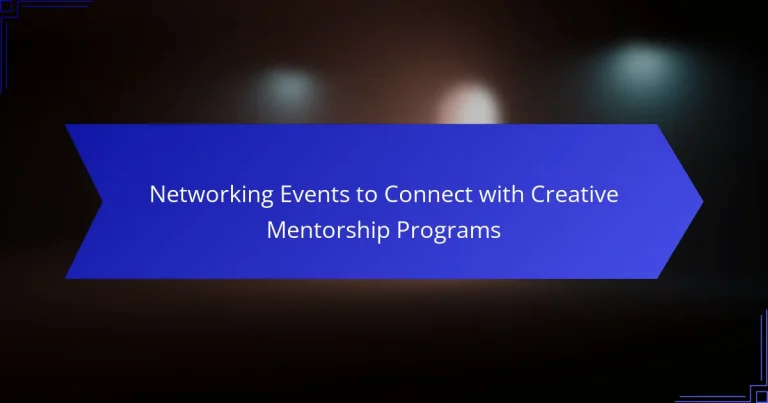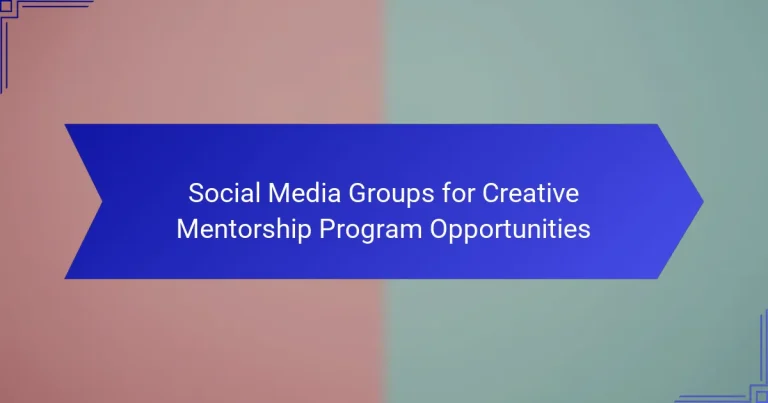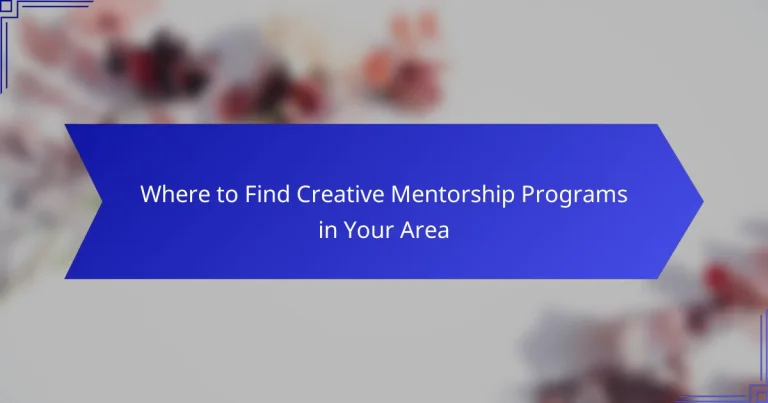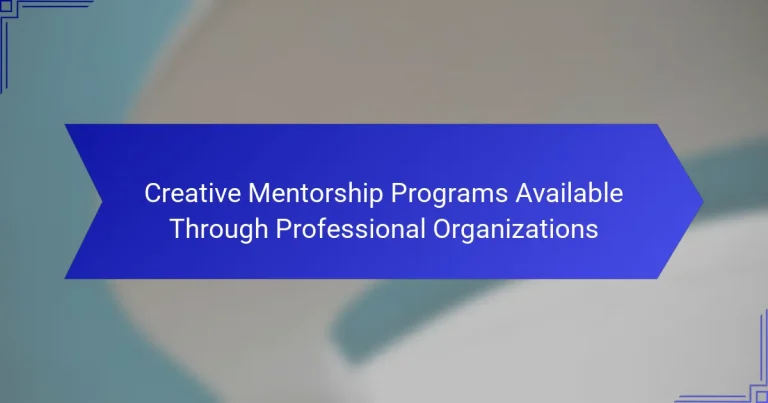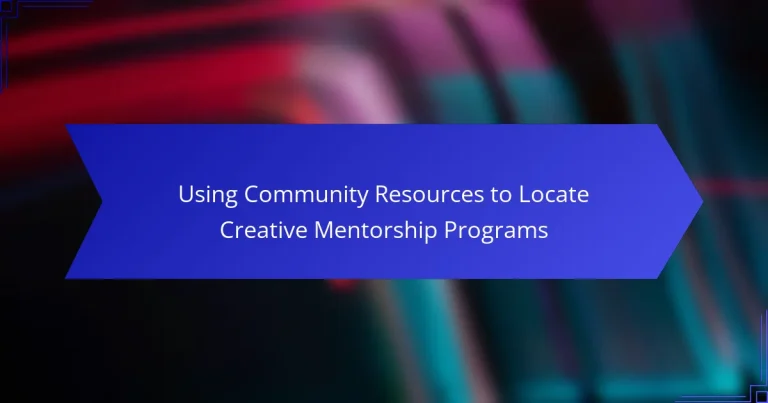What are the best creative mentorship programs in the USA?
The best creative mentorship programs in the USA offer structured guidance, networking opportunities, and resources for aspiring artists and creatives. Programs like Creative Mornings, Young Arts, and Adobe Creative Residency stand out for their unique approaches and support systems.
Creative Mornings
Creative Mornings is a global breakfast lecture series for the creative community, providing a platform for networking and inspiration. Each month, local chapters host talks featuring influential speakers from various creative fields, fostering a sense of community and collaboration.
To participate, find a chapter near you and register for events, which are typically free or low-cost. Engaging with fellow creatives can lead to valuable connections and potential mentorship opportunities.
Young Arts
Young Arts is a national program that identifies and supports talented young artists in the visual, performing, and literary arts. Participants receive mentorship from established artists, as well as opportunities for scholarships and awards.
To apply, students aged 15-18 must submit their work in various categories, with selected finalists receiving mentorship and the chance to showcase their talents. This program is an excellent way to gain exposure and professional guidance early in your artistic career.
Adobe Creative Residency
The Adobe Creative Residency offers emerging creatives a year-long opportunity to work on personal projects while receiving mentorship and resources from Adobe. Residents are provided with a stipend, software, and access to Adobe’s network of professionals.
To apply, candidates must submit a project proposal that showcases their creative vision. This program is ideal for those looking to develop their skills while working on innovative projects with the support of a leading company in the creative software industry.
How to choose a creative mentorship program?
Choosing a creative mentorship program involves evaluating its structure, the expertise of its mentors, and the program’s location and accessibility. A well-suited program aligns with your goals and offers a supportive environment for growth.
Evaluate program structure
Assess the program’s format, duration, and frequency of meetings. Look for programs that offer a mix of one-on-one sessions, group workshops, and practical projects, as this variety can enhance learning.
Consider whether the program is part-time or full-time, and how long it lasts. A program lasting several weeks to a few months may provide enough time for meaningful development without overwhelming your schedule.
Assess mentor expertise
Investigate the backgrounds of potential mentors to ensure they have relevant experience in your field. Look for mentors who have a proven track record of success and can provide insights based on real-world challenges.
Check if the mentors have experience teaching or guiding others, as this can significantly impact the quality of mentorship. Testimonials from past mentees can also provide valuable insights into their effectiveness.
Consider location and accessibility
Evaluate the program’s location, especially if it requires in-person attendance. Programs located in major creative hubs may offer more networking opportunities but could also be more competitive.
Accessibility is crucial; consider whether the program is available online or in a hybrid format. Online programs can provide flexibility, allowing you to participate from anywhere, which is particularly beneficial if you have a busy schedule or live in a remote area.
What are the benefits of creative mentorship programs?
Creative mentorship programs offer valuable advantages such as skill enhancement, networking, and tailored feedback. These programs connect individuals with experienced mentors who can guide their development and help them navigate their creative journeys.
Skill development
Participating in a creative mentorship program can significantly boost your skills in your chosen field. Mentors provide insights and techniques that may not be available through traditional education, allowing you to learn practical applications and best practices.
Consider setting specific goals for your skill development. For example, if you are an aspiring graphic designer, you might focus on mastering software like Adobe Creative Suite or improving your understanding of color theory. Regular check-ins with your mentor can help track your progress.
Networking opportunities
Creative mentorship programs often facilitate connections with industry professionals, opening doors to new opportunities. These networks can lead to collaborations, job offers, or introductions to influential figures in your field.
To maximize networking benefits, actively engage with your mentor’s contacts and participate in events they recommend. Building relationships within your mentor’s network can enhance your visibility and credibility in the creative community.
Personalized feedback
One of the key advantages of mentorship is receiving personalized feedback tailored to your unique strengths and weaknesses. This targeted guidance helps you refine your work and develop a clearer artistic vision.
When seeking feedback, be specific about the areas you want to improve. For instance, if you’re a writer, ask your mentor to focus on narrative structure or character development. Constructive criticism can be invaluable for your growth and confidence.
What are the costs associated with creative mentorship programs?
Creative mentorship programs can involve various costs, including program fees, travel expenses, and material costs. Understanding these expenses helps you budget effectively and choose a program that aligns with your financial situation.
Program fees
Program fees for creative mentorship can vary widely, typically ranging from a few hundred to several thousand dollars. Factors influencing these fees include the program’s duration, the mentor’s experience, and the resources provided. Some programs may offer tiered pricing based on the level of access or additional services.
When evaluating program fees, consider what is included in the cost. Look for programs that provide clear details on what you will receive, such as one-on-one sessions, workshops, or networking opportunities.
Travel expenses
Travel expenses can significantly impact the overall cost of participating in a mentorship program, especially if it requires attending sessions in person. Costs may include airfare, accommodation, and local transportation. Depending on the program’s location, these expenses can add up quickly.
To manage travel costs, explore options like virtual mentorship programs or local opportunities. If in-person attendance is necessary, consider budgeting for travel well in advance and looking for deals on flights and hotels.
Material costs
Material costs refer to any supplies or resources you may need to participate effectively in a mentorship program. This could include books, software, or art supplies, depending on the creative field. These costs can range from minimal to substantial, depending on the program’s requirements.
Before committing to a program, create a checklist of potential material costs and research what is essential versus optional. This will help you avoid unexpected expenses and ensure you are well-prepared for your mentorship experience.
How to apply for creative mentorship programs?
Applying for creative mentorship programs typically involves a few key steps, including preparing your portfolio, writing a personal statement, and gathering recommendations. Each of these components plays a crucial role in showcasing your skills and passion to potential mentors.
Prepare a portfolio
Your portfolio is a vital part of your application, as it demonstrates your creative abilities and style. Include a variety of work that showcases your range, such as completed projects, sketches, or digital designs. Aim for a selection of around 8-12 pieces that highlight your best work.
When assembling your portfolio, consider the format. Digital portfolios are often preferred, as they can be easily shared and viewed. Use platforms like Behance or create a personal website to present your work professionally.
Write a personal statement
A personal statement should convey your motivations for seeking mentorship and your goals in the creative field. Be authentic and specific about what you hope to learn and how the mentorship aligns with your aspirations. Aim for clarity and passion in your writing.
Keep your statement concise, ideally around 500 words. Use this opportunity to reflect on your creative journey, any challenges you’ve faced, and how mentorship could help you overcome them.
Gather recommendations
Recommendations from professionals in your field can significantly enhance your application. Choose individuals who know your work well and can speak to your skills, character, and potential. This could include former teachers, employers, or colleagues.
Provide your recommenders with context about the mentorship program and what qualities the selection committee values. Aim to secure at least two to three strong recommendations to strengthen your application. Make sure to ask well in advance to give them ample time to write thoughtful letters.
What are the success stories from creative mentorship programs?
Creative mentorship programs have led to numerous success stories, showcasing the transformative impact of guidance and support. Many participants have gone on to achieve significant milestones in their careers, often attributing their progress to the insights and connections gained through these programs.
Examples of successful mentorship pairings
Successful mentorship pairings often involve experienced professionals guiding emerging talents. For instance, a graphic designer paired with a seasoned art director can lead to the designer developing a unique portfolio that attracts high-profile clients. Such relationships can also foster collaboration on projects that elevate both parties’ visibility in the industry.
Impact on career trajectories
Mentorship programs can dramatically alter career trajectories. Participants frequently report accelerated skill development and increased confidence, which can result in promotions or new job opportunities. For example, a mentee in a writing program may secure a publishing deal after refining their craft with the help of an established author.
Long-term benefits of mentorship
The long-term benefits of creative mentorship extend beyond immediate career advancements. Many mentees develop lasting professional networks that provide ongoing support and collaboration opportunities. Additionally, the skills and insights gained through mentorship often lead to a deeper understanding of industry trends and best practices, which can be invaluable throughout one’s career.

